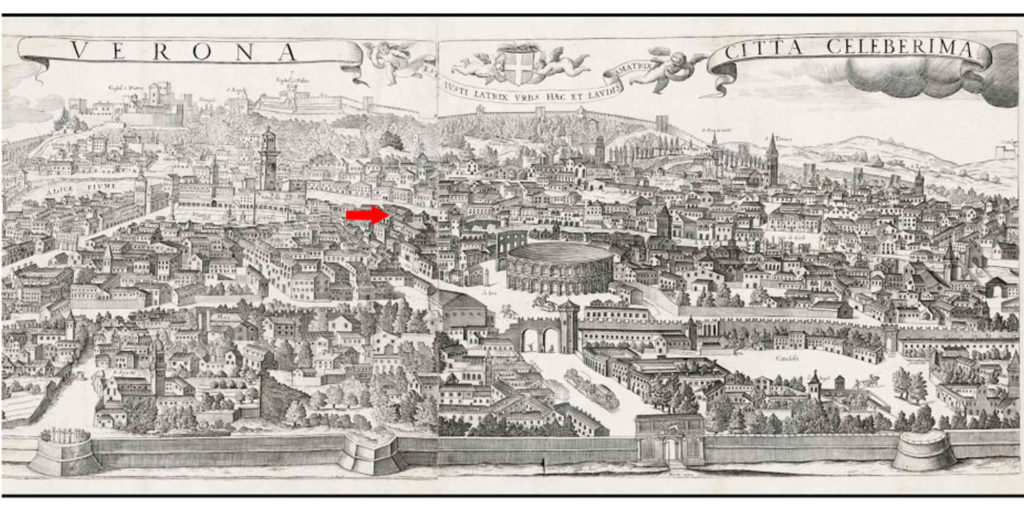Verona, town of love
Thousands of people from all over the world have always come to Verona, which is today the fourth most visited town in Italy.
Verona, on the river Adige, is known for its architectural and natural beauties and the suggestive performances in the Roman Arena, which fascinate lots of tourists during the opera season. Verona is above all the city of Romeo and Juliet. Verona is the place of the Shakespearian legend that evokes in everyone the magic of the most famous love story. In Juliet’s courtyard everyone takes a photo under the famous balcony or near Juliet’s statue, countless lovers write their names on Juliet’s wall and leave their notes in the special mailbox to “Juliet, Verona”.
Romeo and Juliet, fact or fiction?
Did Romeo and Juliet really exist? The popular tradition says yes, but the Veronese chronicles of XIII century do not report any historical evidence of the sad story, which according to the literary sources took place in Verona in 1302, under the rule of Bartolomeo della Scala. “Montecchi” (or “Monticoli”) family and “Cappelletti (or “Dal Cappello”) family really lived in thirteen-century Verona. The first person to write about the two rival houses was Dante Alighieri who in his Comedy (VI canto of Purgatorio) says: “Vieni a veder Montecchi e Cappelletti, Monaldi e Filippeschi, uom sanza cura: color già tristi, e questi con sospetti” (come and see Montagues and Capulets,/ Monaldi and Filippeschi,/ Oh heedless men:/ These dreading ill which those e’en now besets”. Dante probably referred to the feud between Guelfi and Ghibellini and their supporters in medieval Verona and all around Italy. The literary origin of the story of Romeo and Juliet dates back to 1530, when the Italian novelist Luigi Da Porto wrote his “Istoria novellamente ritrovata di due nobili amanti”. The plot was also used by Matteo Bandello some years later in his novel which had a huge success and was translated into French. This work was then taken and re-written in verses by Artur Brooke. The poem was surely the main source of inspiration for Shakespeare, who wrote his “Romeo and Juliet” in 1596, which has become in the course of time a universal myth all over the world.
On the traces of Romeo and Juliet – The places of legend
Juliet’s House
Capuleti family (originally Dal Cappello) has lived since the thirteen century in the lovely house in Via Cappello 23, which is today known as “Juliet’s House”. On the keystone of the inner arch leading from the street into the courtyard we can see the emblem certifying its ownership, with the hat embossed in the marble. The restoration that gave the building its present-day appearance was executed around 1940 by Antonio Avena, who at the time was director of the museums, who added to the medieval main body some components of Romanesque and Gothic styles, compliant with a conception of the Middle Ages that was still romantic.
Through a round brick arch covered with countless love inscriptions and graffiti you reach the courtyard of the building. You discover a Gothic entrance portal, a number of trefoil windows and on the first floor the famous balcony upon which Juliet promised her love to Romeo. Towards the wall in the back, is the famous bronze statue of Juliet which belongs, together with Juliet’s red Mailbox, to the suggestive scenery of Juliet’s House.
Romeo’s House
The so called House of Romeo is a medieval complex in via Arche Scaligere. The building is one of the most representative examples of fortified houses, so that it is more like a castle or a fortress. The legend wants it to be Romeo’s house according to a document relating the fires raging throughout the city because of the fighting between count Bonifacio and the supporters of the Montagues in the area. The document locates Montagues’ houses right here. The Palazzo on the contrary belonged to a branch of the wealthy Veronese Nogarola family, close friends of the Della Scalas. The majestic Romanesque portal is adorned with stone and brick and leads into the courtyard with a loggia and round arches with two-colored lintels. Red marble pillars are adorned with fruit and flower motifs. The house is private and can be seen only from the outside. A plaque bears the inscription of a fragment of the first Act of Shakespeare’s tragedy: “O where is Romeo?/ Tut I have lost myself, I am not here,/ this is not Romeo, he’s some other where”.
Juliet’s Grave
Juliet’s Grave lies in the ancient convent of San Francesco al Corso and is one of the main places for the celebration of the Verona legend. The building now belongs to the City and besides the crypt and the garden includes a charming fresco museum. The grave is a plain, red marble sarcophagus which in the early XIX century had already become a place of pilgrimage and veneration. Famous writers and poets visited the place reporting very romantic descriptions, among them George Byron and Charles Dickens. Like many other tourists, even Maria Luisa of Austria, Napoleon’s widow, in 1822 took a few pieces of stone to make a precious necklace. Today the grave has been moved to a suggestive crypt where people can still live the romantic atmosphere of Shakespeare’s poetry.

